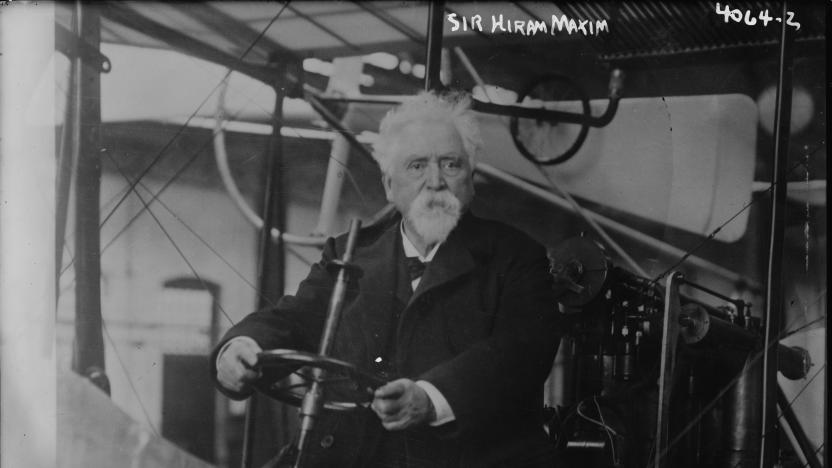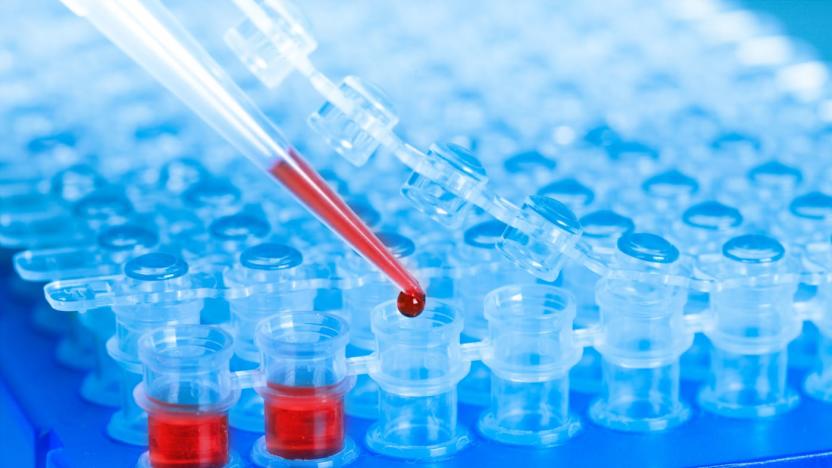Edison
Latest

Hitting the Books: Why nobody knows Hiram Maxim, inventor of the incandescent lightbulb
In "The Things We Make, Dr. Bill Hammack, recounts the tale of Hiram Maxim, an irrepressible engineer whose novel filament production method would have made him a household name — had Thomas Edison not helped himself to Maxim's design.

Edison Mail iOS bug showed messages intended for other people
A bug in Edison Mail's iOS app showed messages from strangers.

UC Santa Barbara sues Amazon and IKEA over LED lighting
UC Santa Barbara has had enough of retailers selling its patented LED light bulb technology without authorization. This week, the university filed a lawsuit charging Amazon, IKEA, Walmart, Target and Bed Bath & Beyond with infringing its patents. According to Nixon Peabody, the law firm representing UC Santa Barbara, this is the "first-of-its-kind direct patent enforcement campaign against an entire industry."

California is set to hit its green-energy goals a decade early
California is both the nation's leading renewable-energy proponent and one of the few states to actually put its power where its mouth is. In November, the California Energy Commission released its annual Renewable Portfolio Standard (RPS) report which found that the state's three investor-owned utilities -- Pacific Gas & Electric, Southern California Edison and San Diego Gas & Electric -- are on track to collectively offer 50 percent of their electricity from renewable resources by 2020. That's a full decade faster than anyone had anticipated. Reports like these have been used to promote clean-energy production throughout the US and the rest of the world since the 1970s. However, it wasn't until 2002 that California codified the practice. But despite being in effect for only 15 years, California's mandatory reporting has become a potent tool in fighting greenhouse-gas emissions throughout the state.

Intel has less competition against Raspberry Pi
Say goodbye to Intel's Edison, Joule and Galileo compute modules. The company has unceremoniously canceled its developer kit lineup, which were meant to give it a foothold in the burgeoning Internet of Things arena, ZDNet reports. Additionally, Intel also canceled several of its Recon Jet smart glasses products, though that's less of a surprise. With Galileo, Intel wanted to compete directly against the ARM-powered Raspberry Pi, while Edison shrunk down a full development kit to the size of an SD card. Joule, which launched last year, was its most powerful compute module yet.

Theranos is laying off another 155 employees
Just three months after the company laid off 340 employees, Theranos' workforce is being slashed again. The company announced today that it will part ways with another 155 employees, leaving the current Theranos headcount at 220.

Google makes it easier to get Internet of Things devices online
It's relatively easy to build your own Internet of Things hardware, but the software is another story. How do you connect it to cloud services, push updates or just write code? Google might help. It's trotting out a developer preview of Android Things, a toolbox that theoretically makes connecting IoT devices as straightforward as writing an Android app. Think of it as a more mature, more accessible Project Brillo. You're not only using ordinary Android developer tools (Android Studio and the official SDK), but tapping into Google Play Services and Google Cloud Platform. In theory, most of the heavy lifting is done for you -- future versions in the months ahead will even grab regular updates (both from you and Google) and use Google's ad hoc Weave networking.

Ben Heck's Intel Edison laser harp, part 1
try{document.getElementById("aol-cms-player-1").style.display="none";}catch(e){} Inspired by #MTFBerlin and the projects at Music Tech Fest, the Ben Heck Show team uses Intel's Edison chip to build an electronic harp. The team harness the power of lasers, virtual studio technology and the prototyping tools at their disposal in the workshop to produce a fully working instrument. Ben uses an oscilloscope to measure the capability of a photoresistor when hit by a laser. Felix writes up code to handle the input from the photoresistors into the Intel Edison chip, which will then be processed and exported using an audio codec. Finally, Ben gets on with designing the harp and the housing for the lasers using Adobe Illustrator. What instrument would you like to control with the power of electronics? Get in touch over on the element14 Community, where you can also find the build files and behind-the-scenes footage.

WSJ: Theranos is voiding and revising past blood test results
As Theranos faces increased scrutiny from regulators, tonight the Wall Street Journal is reporting the company is taking an extraordinary step by voiding its own blood test results going back two years. According to the Journal, the company is telling the Centers for Medicare and Medicaid Services that it has issued "tens of thousands" of corrected blood test reports, covering results that have been revised or voided altogether.

Theranos lab failed to meet its own accuracy standards
Theranos' proprietary blood-testing methods failed to meet the company's own standards as often as 87 percent of the time, according to a new report. Released by the CMS (Centers for Medicare and Medicaid Services) agency and seen in unredacted form by the WSJ, the data confirms that the company knew its finger pin-prick tests were often wrong when it used them in October, 2014. It has since pulled most of the testing done by its key "Edison" machine and can only perform a single herpes test. However, the FDA and CMS received complaints from Theranos employees that even that one was "tainted by breaches in research protocol."

Acer's smart diaper sniffs out baby troubles
Ever since the introduction of the Edison, Intel's been actively pitching this tiny computer module to makers by way of workshops and hackathons. At Computex, the chip giant took the opportunity to show off the latest round of hacks based on its $50 kit, and we were amused by one particular demo: the DiaperPie*, a smart diaper solution created by four Acer engineers. The module -- which will be the size of a coin if Acer commercializes it -- sits inside a regular diaper and is able to monitor a baby's temperature plus sleeping posture, as well as detecting the presence of pee (moisture) and poo (methane) in the diaper. The data is logged on both the app (via Bluetooth LE) and the cloud, and if the baby needs attention, you'll get a notification. Given that we haven't heard much about the previous smart diaper attempt, it'd be cool to see Acer realize this project. *Ted plush not included.

Play Whac-A-Mole on these weather-predicting smart ceramics
Most consumer IoT devices we've come across are made out of dull plastic, so excuse us for getting a bit excited over these porcelain smart mugs and vases at IDF in Shenzhen. Yes, porcelain, courtesy of Chinese ODM Thread Technology who's integrated Intel's tiny Edison computer module into these white ware pieces. And thanks to the translucent nature of the ceramic material, the company's able to add a simple 12 x 16-dot LED touchscreen underneath the inner wall. Once turned on, you can scroll through features such as weather forecast, music (either from a phone via Bluetooth or from the 4GB of onboard storage; built-in speaker), WeChat notification (voice playback and reply supported), dice and even a simple Whac-A-Mole game. Both devices have a conductive charging mat as well.

Inside Intel's insanely futuristic CES booth
While Intel's biggest news at CES this year wasn't a processor or any of the futuristic products it powers, its booth is still packed with eye-pleasing, Edison-packing gadgets. You could take our word for it, or you could check out the 3D-printed prosthetics, robot spider dresses and digitally rendered sand people in the photo and video tours below. For more from Intel and beyond, check out our 2015 CES Field Guide.

BabyBe brings premature children closer to their mothers
CES 2015 does not lack for connected devices. Lightbulbs, beds, socks... seriously, everything is a connected device at CES. But, let's be honest with ourselves: These are luxury goods for people with disposable income. BabyBe is using Intel's connected-device platform Edison to actually better the lives of people, specifically premature babies and their mothers. The most important component is the "Cradle," a pad embedded with air bladders and heating elements, sheathed in a medically safe polyurethane. It's soft and a little odd-feeling. It's supposed to mimic the density and texture of human skin, but kind of ends up falling into uncanny valley territory. The air sacks inside mimic the heartbeat and chest movement of the mother, who can't hold her fragile, premature child.

Here are seven cool projects made possible with Intel's tiny computer
Thinking about using Intel Edison for your next builder project, but feeling a little uninspired? Don't worry: IDF 2014 is rife with examples of how to use the company's new development board. In the weeks leading up to the conference, Intel employees and partners alike used it to build robots, memes, high-altitude balloons and even clothing for a small showcase of the development board's potential. Care for a peek? Check out the gallery below to see some of Engadget's favorite Edison projects from IDF 2014.

Intel will let you build your own 3D-printed robot later this year
Intel CEO brought a robotic companion named Jimmy with him on stage at Code Conference today. Jimmy is a 3D-printed robot capable of walking, talking, moving his arms, dancing and even tweeting, and it's the key to Intel's vision of the future of robotics. Starting later this year, the company will make an open source robot kit with 3D-printed parts available to consumers for $1,600, with a research version for $16,000. The former will run on Intel Edison, the company's computer-on-a-chip, while the latter will be powered by a Core i5 processor.

Intel's SD card-sized computer may not be so tiny after all
Back at CES, Intel made a big deal of the fact that it could squeeze a Linux-based PC with Bluetooth and WiFi into the size and shape of an SD card. However, with just a few months to go before the launch of these miniscule Edison development boards, it looks like the chip-maker has changed tack. Instead of being based on the Quark SoC, which was specifically designed for wearables and the Internet of Things, the first Edison products will actually rely on a more traditional Atom chip -- in other words, the same sort used in many current Windows tablets and hybrids. An Edison PC based on Atom should deliver more grunt and connectivity options compared to Quark, and for less money, but it'd be too chubby to ever get accidentally jammed in an SD slot. That's why Intel has been forced to admit that, while it continues to work on Quark, the Edison devices coming this summer will be "slightly larger" than was first claimed.

Intel announces Edison: a 22nm dual-core PC the size of an SD card
Four months ago, Intel unveiled its Quark SoC at IDF. Today at CES 2014, company CEO Brian Krzanich wants to introduce you to Edison, a miniature computer based on the same technology condensed into the form factor of an SD card. The tiny computer is built on the company's 22nm transistor technology, runs Linux and has built-in WiFi and Bluetooth modules. What's more, the tiny machine can connect to its own app store. Naturally, the device is aimed at developers, Krzanich says, who he hopes will use it to build the next generation of wearable and connected devices. Even so, Intel is leading by example, and showed a small collection of "Nursery 2.0" products using embedded Edison chips: a toy frog that reports an infant's vitals to a parent via an LED coffee cup, for example, and a milk warmer that starts heating when another connected item (the frog, again) hears the baby cry. Still, even Intel knows that developers need more than a good example to motivate them, and nothing gets the creative juices flowing quite like the promise of an award. To that end, the company has announced the "Make it Wearable" competition, and says it will be offering up to $1.3 million in prizes for developers churning out wearable tech. The full details of the contest weren't revealed at the show, but Krzanich did say that first prize would walk away with a cool $500,000. Oh, and if you're eyeballing Edison for your award-winning idea? It'll be available sometime in mid-2014. Alexis Santos contributed to this report.

Ubiquitous nanotubes could reboot Edison-era nickel-iron battery technology
Back in the 1920s, Thomas Edison's dream of an electric automobile was ultimately foiled by those meddling petroleum engines. But thanks to nanotube research from Stanford University, one legacy from that era may regain some glory: nickel-iron batteries. It turns out that carbon nanotubes doped with nickel and iron crystals can top up the normally slow-charging cells in a matter of minutes -- according to the scientists, that's almost 1,000 times faster than in the past. Although the batteries couldn't power your Volt or Prius due to a lack of energy density, they could give an extra jolt to their lithium-ion siblings for quicker starts and regenerative braking. The researchers are working on improving stability to allow more charging cycles, but it might be an extra in-your-face for Edison if it pans out.

Motorola LTE handset emerges with qHD Super AMOLED display, questionable identity
Well, what do we have here? According to "trusted sources" over at This Is My Next it's a Motorola Spyder, or a Droid RAZR, or maybe even the Droid HD we peeped back in August. Whatever the name, the phone is apparently packing a first-of-its-kind 4.3-inch, 960 x 540 qHD super AMOLED display. The rumored LTE handset also supposedly contains a 1.2GHz dual-core processor, 1GB of RAM, an 8 megapixel, 1080p rear-facing camera and HD front-facing camera, and is apparently outfitted in Gorilla Glass and Kevlar. TIMN is also boasting exclusive new details for the recently outed Atrix 2. It seems the name is confirmed as well as a handful of previously identified specs. What's more, the phone's got a couple of accessories on board, including a laptop dock called the Lapdock 100, also rumored to play nice with the Spyder, or RAZR, or HD. More images of both devices await you at the source links below.











